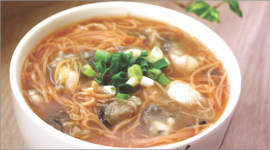
SNAPSHOT
| Population |
2.6 million |
| Cuisine | Taiwanese, with influences from Hakka, Fujianese, Cantonese, Shanghainese and Sichuan cuisines |
| Signature dishes | Beef noodle soup, oyster pancakes, pork dumplings, three-cup chicken (san bei ji), pig’s blood soup, congee |
| Wine culture | Developing wine market with good potential for growth |
| Wine duty | Approximately US$2 per bottle plus 16% additional taxes |

OVERVIEW OF TAIWANESE CUISINE
While the Taiwanese people use condiments of northern Asian countries such as soy sauce, rice wine and sesame oil, a combination of additional ingredients create more unique flavours. These can include black beans, miso, pickled radishes, peanuts, chilli peppers and herbs such as parsley, cilantro and Taiwanese local basil.
Local dishes are often lighter than the mainland Chinese versions, with a focus on freshness. The much-loved basil and cilantro are often topped as garnishes and flavourings to many soups and stir fries. This fondness for lightness and freshness is evident in the widespread use of a clear, light, rice wine, similar to mirin in Japan, over the stronger-flavoured yellow Shaoxing wine prevalent in traditional Chinese cooking.
Small plates or snack food are an essential part of the Taiwanese meal. These feature a wide range of wonderful flavours including a variety of stinky tofu, dumplings, oyster pancakes, fried anchovies with peanuts, pig’s blood pudding and pickled cucumbers. These small dishes, eaten as snacks or part of a meal, are at the heart of the local cuisine. They are the everyday comfort foods that the Taiwanese miss when they travel abroad. Beyond the island, even in Hong Kong and large southern Chinese cities, good Taiwanese restaurants are surprisingly difficult to find.
FOOD AND DINING CULTURE
Even the most articulate locals have difficulty defining Taiwanese food. There is often some reference to southern Chinese cuisines, even southeast Asian flavours and suggestions of Japanese influence. Most will give examples such as beef noodle soup, oyster omelette or turnip cake, as being Taiwanese; but often, after some consideration, they will scratch their heads trying to come up with other examples since most of the dishes have their origins outside of Taiwan. When the people coming from Fujian began to arrive in the 1600s, they found the main island filled with bountiful fruits, vegetables and seafood. Even now, more than 400 years later, the mountains still provide a wealth of edible vegetables and seafood is abundant and cheap. Fujians brought with them the love for umami-laden soups, slow-cooked foods and flavours that are light and subtle. They are known to favour the salty, tangy flavours of shacha sauce (savoury and spicy paste) and the umami-rich taste of wine lees.
During the 1600s, Ming loyalist Cheng Cheng-kung arrived in Taiwan with over 30,000 mainland Chinese. Cheng’s goal, which never materialised, was to use the island as a base to overthrow the Qing rulers. Fast forward nearly 350 years later in 1949 with the mass exodus of millions of Chinese from all over the mainland into Taiwan, this time with Chiang Kai-shek. These included chefs, farmers as well as soldiers and other military officials. Thus, all types of Chinese cuisine are well represented in Taiwan, including favourites such as Sichuan, Hunanese, Shanghainese and northern Chinese food. In many instances, the original dishes have become ‘Taiwanised.’ For example, Taiwan’s ‘Sichuan noodle soup’ uses fresh herbs, has lighter broth, less oil and only bears a slight resemblance to the original classic noodle soup dish.
However, the dishes most closely associated with Taiwanese cuisine are not found in restaurants but in the street side and night market food stalls. Xiao chi, or small eats, is at the core of Taiwanese everyday food – including oyster pancakes, rich beef noodle soup, oyster noodle soup, meat dumplings and congee or rice porridge. The best examples are widely available in busy food stalls or in markets such as Shilin Night Market.









